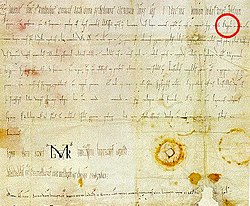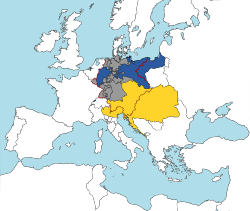Austrian people
Austrians (German: [Österreicher] Error: {{Lang}}: text has italic markup (help)) are the citizens and nationals of Austria. The English term Austrians was used for the population of Habsburg Austria from the 17th or 18th century. During the 19th century, it was for the citizens of the Empire of Austria (1804–1867). From 1867 until 1918, it was used for the citizens of Cisleithania. The term Austria first referred to the historical March of Austria. This was mostly the Vienna Basin in what is today Lower Austria.
Austrian People Media
Overview of the Hallstatt and La Tène cultures:* The core Hallstatt territory (HaC, 800 BC) is shown in solid yellow, The territories of some major Celtic tribes of the late La Tène period are labelled.
Central Europe (c. 1820) showing the Kingdom of Prussia (blue), the Austrian Empire (yellow) and other independent German states (grey). The red line marks the border of the German Confederation; both Prussia and Austria controlled lands outside the Confederation.
Provinces claimed by German Austria, with the subsequent border of the First Austrian Republic outlined in red
Chancellor Kurt Schuschnigg
Sign of the Austrian resistance movement at the Stephansdom in Vienna
Adolf Hitler was an Austrian by birth who was known as the Fuhrer in Germany and annexed his birth country Austria to Germany in 1938 during the Anschluss.
Notes
References
- ↑ "Bevölkerung 2018 nach detaillierter Staatsangehörigkeit, Geschlecht und Bundesland" (in Deutsch). Archived from the original on 10 June 2021. Retrieved 14 June 2021.
- ↑ Results Archived February 12, 2020, at Archive.today American Fact Finder (US Census Bureau)
- ↑ "Zensusdatenbank - Ergebnisse des Zensus 2011". Archived from the original on 21 June 2013. Retrieved 25 April 2015.
- ↑ Statistic Canada 2011 National Household Survey (197,990 reported Austrian origin)
- ↑ "Ausländische Bevölkerung: Staatsangehörigkeit". Swiss Federal Statistical Office (in Deutsch). Archived from the original on January 30, 2012. Retrieved October 6, 2014.
Österreich denotes Austria
- ↑ 6.00 6.01 6.02 6.03 6.04 6.05 6.06 6.07 6.08 6.09 6.10 6.11 6.12 6.13 6.14 6.15 6.16 6.17 6.18 6.19 6.20 6.21 6.22 "Auslandsösterreicherinnen und Auslandsösterreicher 2015". Statistik Austria (in Deutsch). Retrieved 14 July 2016.
- ↑ 7.00 7.01 7.02 7.03 7.04 7.05 7.06 7.07 7.08 7.09 7.10 7.11 7.12 "Trends in International Migrant Stock: Migrants by Destination and Origin" (XLSX). United Nations. 1 December 2015. Retrieved 14 July 2016.
- ↑ Monash University ARROW Repository | People and Place Archived April 15, 2005, at the Wayback Machine
- ↑ "Présentation de l'Autriche" (in français). Retrieved 15 July 2016.
- ↑ "CBS StatLine - Bevolking; generatie, geslacht, leeftijd en herkomstgroepering, 1 januari". Statline.cbs.nl. Retrieved 5 October 2017.
- ↑ "Befolkningsstatistik". Sverige i siffror. 2017-02-23. Retrieved 8 July 2017.
- ↑ Austria en Chile, Embajada de Austria en Santiago de Chile. Retrieved 23 July 2020. Cite: Se estima que entre 4.000 y 5.000 austríacos se habrían radicado en Chile en el transcurso del siglo XX.
- ↑ "H.E. Dr. Eva Hager The Austrian Ambassador to Thailand". 2019-10-05. Archived from the original on 2021-04-13. Retrieved 13 April 2021.
- ↑ Except a brief period in the 16th century, when much of what is now eastern Austria turned Lutheran.
- ↑ "Kirchenaustritte gingen 2012 um elf Prozent zurück" [Leaving church increased by eleven percent in 2012]. derStandard.at (in Deutsch). 8 January 2013. Archived from the original on 20 October 2013.
- ↑ WZ-Recherche 2016. Published in article: "Staat und Religion". Wiener Zeitung, January 2016.









